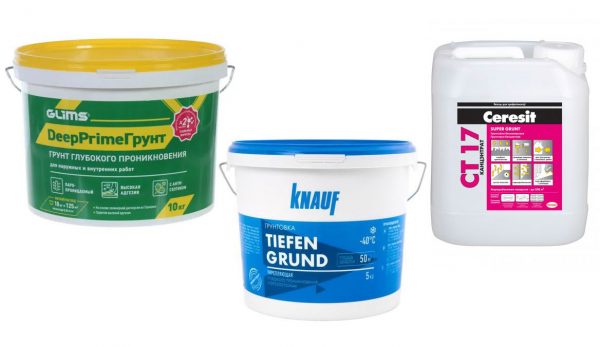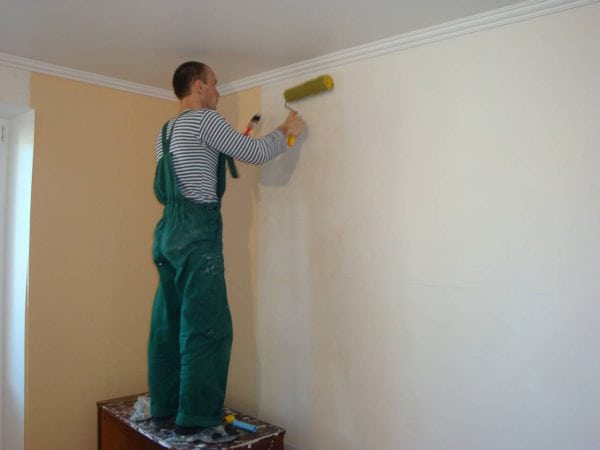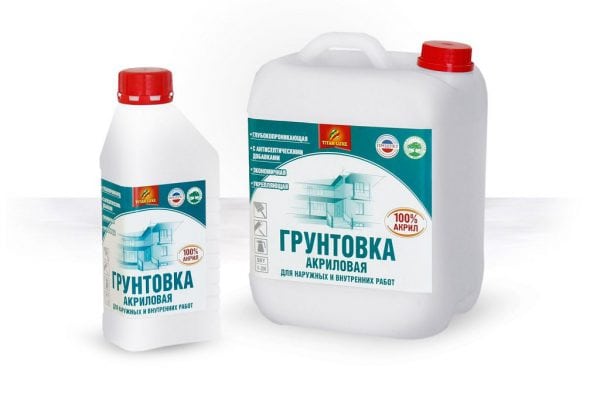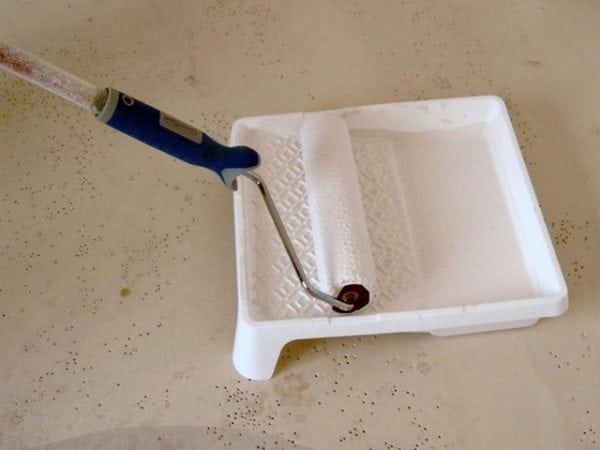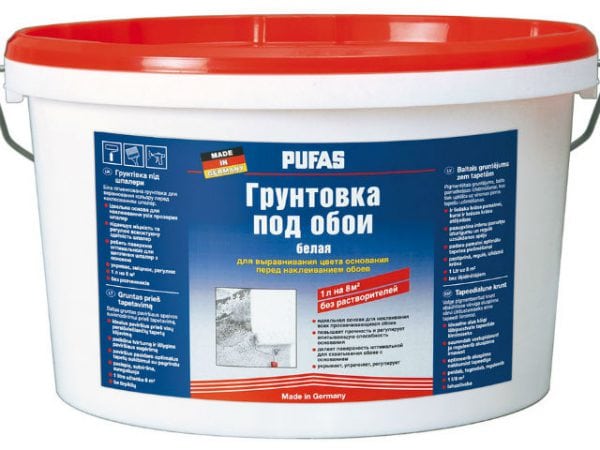Wallpaper is one of the most popular types of interior decoration: non-woven, vinyl, paper, textile, velvet, embossed ... The modern market for wallpaper products offers such a rich variety of these materials that just your eyes run wide.
- How to choose a primer
- What are the compositions
- Primer GLIMS Prime Primer
- Wall treatment
- When to glue wallpaper
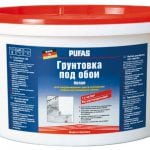
All kinds of colors, original designs, different types of bases, different prices. In order for the repair to be carried out efficiently, and the decorative coating lasted longer, not only good glue, but also a primer for the wallpaper will be required.
Do I need to prime the walls before wallpapering? And our answer is yes. I have to! And why. A primer is a special impregnation of walls (usually a white liquid), which is used at the stage of preparing the surface for gluing.
- The special composition prevents the formation of mold and fungus, protects the base from moisture, provides additional adhesion and strength of the base.
- The primer acts as a connecting link between the wall and the finishing materials. The adhesive properties of wallpaper glue and base materials increase.
- After priming, the consumption of installation solution is significantly reduced. The work itself will go better. Note that you can prepare the surface for gluing yourself, without involving outsiders. You just need to know what materials to use, what is the sequence of work?
How to choose a primer
The primer of the walls under the wallpaper is carried out several times. First, to strengthen the base and ensure adhesion to the mortar (plaster). Then putty or plaster is primed, so that the wallpaper can lay well and hold more firmly. Putty must be primed before gluing the wallpaper. Putty has low moisture resistance; after applying the adhesive, it can absorb liquid, swell and exfoliate.
Almost all primers are white liquid. A separate group is represented by the so-called paint-primers, where white coloring is easy to tint or pigment is already in the composition.
For the first (rough) treatment of the wall with your own hands, you should use a deep penetration solution. It can be an acrylic primer of deep penetration or contact. The main property of deep penetration primer mixtures is to penetrate deeper into the structure of the material 10 mm.
After polymerization (drying), a strong film is formed, water-repellent, but breathable, preventing the destruction of the base, which has antiseptic properties. This is especially necessary if the wall is made of mineral materials.
With a deep penetration primer, the wall should be treated in several layers. Each subsequent layer is applied only after the previous one has completely dried. Deep penetration solutions can dry for quite some time. Therefore, it is recommended to adhere to the technical requirements in working with these materials, especially if you are doing the repair yourself.
All other types of primers are selected based on the type of wallpaper materials. Note that acrylic primer remains the most sought after on the market.It is white, but lends itself to tinting, can be used as a colored substrate for liquid wallpaper.
to contents ↑What are the compositions
The primer of the walls before gluing the wallpaper is one of the important stages of the intermediate work on finishing the surfaces indoors with your own wallpaper. Types of primers, as mentioned, are distributed by composition and properties. For example, heavy wallpaper materials (cullet, non-woven, bamboo, textile) need a stronger adhesion to the base than traditional paper.
Types of primers for wallpaper are divided into several groups:
- Acrylic-based - used for intermediate work on old plaster, cement and concrete, brick and stone, wood, drywall, particleboard and fiberboard. Also applied to putty. Complete drying of the impregnation is achieved after a maximum of 35 hours. It can be used in residential premises due to the absence of a specific smell;
- Based on alkyd resins - more often used for processing wood and metal surfaces, as it has anti-corrosion properties. But on plaster and gypsum, it is better not to use such a primer. The polymerization period depends on the presence of rapidly volatilizing substances;
- Glifthal primers are applied to metal surfaces. After impregnation, it is possible to proceed to further finishing no earlier than in a day. The most effective use in dry, warm rooms;
- Perchlorovinyl mixtures are intended for the treatment of mineral bases and metal. However, this type of impregnation is not recommended for indoor decoration work. Polymerization time is short;
- Based on polyvinyl acetate (PVA) it is better to use if the following material is of the same composition. As for the drying period, this is one of the fastest drying primers: under appropriate conditions, this process lasts only half an hour;
- Polystyrene compounds can be used on wood and plaster. But the composition contains organic solvents, so it is better not to use such a primer in residential premises;
- Phenolic compounds are intended for impregnation of wood and metal.
Another question to the composition: what acts as a diluent? Primers are divided into aqueous and based on organic solvents. The former are safer for DIY repairs. However, in some cases, it is much more effective to use solvent-based (for example, for deep penetration).
There are also universal soils that combine the best properties of this group of building materials. To choose the right one, you can consult with the seller or a specialist in repair matters.
to contents ↑Primer GLIMS Prime Primer
Finished material that does not require solvent or water additives. Due to its characteristics, this primer is in demand among specialists involved in the repair and decoration of premises. The primer of this type has excellent absorbency, making the base stronger, making it suitable for almost any surface.
The antiseptic additives that make up the primer prevent the growth and spread of fungus and mold, which is why GLIMS DeepPrime Soil and GLIMS Prime Soil is very recognizable and in demand among summer builders.
Main advantages:
- increases adhesion;
- suitable for concrete, foam concrete, plastered, putty, drywall or asbestos-cement surface;
- does not create a film;
- serves as an excellent means of binding dust;
- reduces the absorbent ability of the base, and also prevents the appearance and development of the fungus;
- allows you to evenly apply paint to the base and reduce its consumption or glue for wallpaper;
- increases the water resistance of the base.
Wall treatment
How to primer the walls under the wallpaper with your own hands? Good question. This is completely uncomplicated. The work uses a foam roller on a long handle (for the convenience of distributing the solution along the height of the wall). Pour a little impregnation into the bath, dip the roller, squeeze slightly on the lattice side of the bath (so as not to drip), and process the wall.
Distribute the solution evenly over the entire surface. You do not need to use too much solution, but there should not be any dry places on the surface either. The first application is finished, set the instrument aside and wait for the impregnation to dry. More precise information on the drying time is indicated on the packaging of the products you purchased.
to contents ↑What should not be done is to apply a new layer to the previous one that has not yet dried up. This can be believed by touching the hand. Double application is usually sufficient, but sometimes three or more coats are required.
When to glue wallpaper
The primer of the walls before wallpapering is done a few days before the installation of the decorative coating. Therefore, you should be patient and be sure to wait for the complete polymerization of the impregnation. Otherwise, priming will not have the desired effect - better holding the wallpaper on the wall. Then you can safely glue.
To the appropriate wallpaper you need to choose the right mounting solution. Paper, thin and light wallpaper can be glued with ordinary wallpaper glue. For non-woven wallpaper - non-woven glue (non-woven). For vinyl, textile and embossed - vinyl. For heavy, you must definitely choose a special mounting solution of increased strength and resistance to moisture. But most importantly, priming improves the mounting properties of the adhesive.
From the foregoing, it becomes clear why under the wallpaper a primer. Properly selected tool, high-quality do-it-yourself work is the key to the durability of the finish.

